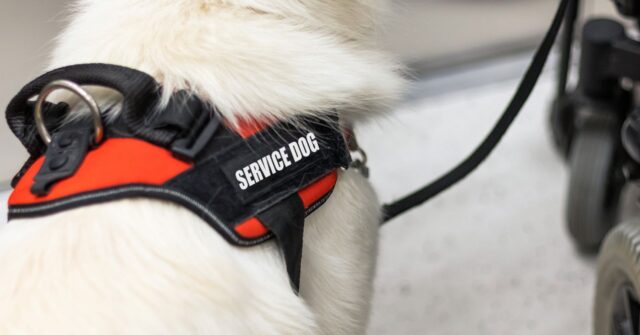Owning a dog that is classified as dangerous can have significant legal ramifications.
These laws are designed to protect the public, but they also place various responsibilities and restrictions on dog owners. Understanding these implications is crucial for anyone considering owning such a breed.
Understanding Dog Aggression and Breed Perceptions
Dog aggression is a multifaceted issue influenced by genetics, environment, and training. It’s essential to differentiate between inherent breed traits and individual dog behaviours.
Public perception often unfairly labels certain breeds as dangerous, which can lead to misguided policies and societal fear.


The Myth of Inherent Aggression in Specific Breeds
Dog breeds often labelled as dangerous, such as Pitbulls, Rottweilers, and Dobermans, are frequently misunderstood.
Contrary to popular belief, these breeds are not inherently more aggressive than others. Their behaviour is largely influenced by their environment, training, and socialization.
For example, a well-trained Rottweiler can be a gentle and loyal companion, while an untrained Labrador can exhibit aggressive behaviour. The key factor is responsible ownership and proper training.
How Media and History Influence Our View of Dog Breeds
Media portrayals and historical events have significantly shaped public perception of certain dog breeds.
Movies, news stories, and sensationalized reports often depict breeds like Pitbulls as inherently dangerous, perpetuating fear and misunderstanding.
Historical uses of certain breeds in dog fighting and as guard dogs have also contributed to their negative image.
This bias can lead to unfair treatment and legislation targeting these breeds without considering individual behaviour.
Studies Debunking Common Misconceptions
Numerous studies have shown that breed alone is not a reliable predictor of aggression.
Research indicates that factors such as a dog’s upbringing, training, and social environment play a more crucial role in determining behaviour.
For instance, a comprehensive study found no significant difference in aggression levels between so-called dangerous breeds and other breeds when controlling for these variables.
These findings suggest that focusing on individual dog behaviour rather than the breed could be more effective in preventing dog attacks.
Legal Frameworks Governing Dog Ownership in Australia
In Australia, the legal frameworks around dog ownership are comprehensive and vary by state and territory.
These laws are designed to ensure public safety while promoting responsible pet ownership. They encompass everything from registration and microchipping to specific regulations for dangerous breeds.
Overview of Australian Laws on Dog Ownership
In Australia, dog ownership is regulated by both federal and state laws. These laws aim to ensure public safety while promoting responsible pet ownership.
Common regulations include mandatory registration, microchipping, and desexing of dogs.
Additionally, specific laws address the handling and control of dangerous dogs, including requirements for secure enclosures and the use of muzzles in public.
State-Specific Legislation and Requirements
Each Australian state has its own set of regulations regarding dog ownership and the management of dangerous breeds.
For example, in New South Wales, the Companion Animals Act 1998 outlines specific requirements for restricted breeds, such as American Pit Bull Terriers and Japanese Tosas.
Owners must adhere to strict guidelines, including secure enclosures, warning signs, and compulsory desexing.
In contrast, states like Victoria and Queensland have their own lists of restricted breeds and corresponding regulations, which may differ slightly in terms of enforcement and penalties.


Implications of Non-Compliance
Failure to comply with dog ownership laws can result in severe consequences for owners. Penalties may include hefty fines, mandatory confiscation of the dog, and in extreme cases, euthanasia of the animal.
Additionally, owners may face legal action if their dog is involved in an attack, leading to potential civil liability for damages and injuries caused.
These implications highlight the importance of understanding and adhering to local regulations to ensure both public safety and the well-being of pets.
Breed-Specific Legislation (BSL) Worldwide
The concept of BSL is rooted in the desire to maintain public safety, yet its execution and impact can vary significantly across different regions.
Understanding the global landscape of these laws provides us with a broader perspective on their effectiveness and challenges.
What is Breed-Specific Legislation?
Breed-Specific Legislation (BSL) refers to laws that restrict or ban certain dog breeds deemed dangerous. These laws aim to reduce dog attacks by targeting breeds perceived to be more aggressive.
BSL often includes regulations such as mandatory muzzling, special registration, and ownership restrictions.
While intended to enhance public safety, BSL is highly controversial and has sparked significant debate among animal welfare advocates and experts.
Examples from Around the World
BSL exists in various forms across the globe. In the United Kingdom, the Dangerous Dogs Act 1991 prohibits the ownership of breeds like the Pit Bull Terrier and Japanese Tosa.
Similarly, countries such as Germany and Spain have enacted strict BSL targeting specific breeds.
In the United States, several states and municipalities have implemented BSL, with varying degrees of enforcement and success.
These examples illustrate the widespread, yet contentious, application of BSL worldwide.
Criticism and Controversy Surrounding BSL
Critics argue that BSL is ineffective and unfairly targets specific breeds rather than addressing the root causes of aggressive behaviour.
Studies have shown that BSL does not significantly reduce dog attacks and often leads to unintended consequences, such as increased euthanasia rates for targeted breeds.
Animal welfare organizations advocate for alternative approaches focusing on responsible ownership, education, and enforcement of existing laws based on individual dog behaviour rather than breed.
The Effectiveness of Breed-Specific Legislation
As we explore the effectiveness of BSL, it’s important to scrutinize the evidence from various studies and reports, providing a balanced view of how these laws perform in reality.


Analysis of BSL Impact on Dog Attacks and Public Safety
Research on the effectiveness of BSL in reducing dog attacks yields mixed results.
Some studies suggest a slight decrease in dog-related injuries following the implementation of BSL, while others find no significant impact.
The variability in findings may be attributed to differences in enforcement, public awareness, and the specific breeds targeted by the legislation.
Overall, the evidence suggests that BSL alone is insufficient to address the complex issue of dog aggression and public safety.
Case Studies: The Successes and Failures of BSL
Several case studies highlight the successes and failures of BSL in various jurisdictions.
For instance, after implementing BSL, Ontario, Canada, reported a decrease in severe dog attacks, but critics argue that other factors, such as improved reporting and enforcement, may have contributed to this decline.
Conversely, the Netherlands repealed its BSL after finding no reduction in dog attacks, shifting focus to responsible ownership and education programs.
These case studies underscore the need for a comprehensive approach to managing dog aggression beyond breed-specific measures.
Alternative Approaches to Managing Dog Safety
Many experts advocate for alternative strategies to improve dog safety, emphasizing the importance of responsible ownership and education.
Programs that focus on training and socialization, public awareness campaigns, and stricter enforcement of general dog control laws have shown promise in reducing dog attacks.
Additionally, some jurisdictions have implemented temperament testing and behaviour-based assessments to identify and manage potentially dangerous dogs, regardless of breed.
These approaches offer a more nuanced and effective solution to enhancing public safety.


The Australian Context: Dangerous Dog Breeds and Public Safety
Within the Australian context, the management of dog breeds considered dangerous involves a complex framework of laws and community expectations. Here, we’ll explore how these elements interact.
Identifying ‘Dangerous Dogs’ in Australian Territories
In Australia, each state and territory maintains a list of restricted or dangerous breeds, including American Pit Bull Terriers, Japanese Tosas, and Fila Brasileiros.
These lists are based on local assessments of risk and historical data on dog attacks.
Owners of these breeds must comply with stringent regulations to ensure public safety, including secure housing, muzzling in public, and mandatory desexing.
The identification of dangerous dogs often relies on visual characteristics and historical breed data, leading to debates about the fairness and accuracy of these assessments.
Public and Legal Reactions to Dog Attacks
Dog attacks in Australia often elicit strong public and legal reactions. High-profile incidents can lead to calls for stricter regulations and harsher penalties for owners of dangerous dogs.
Legal responses typically involve the seizure and possible euthanasia of the attacking dog, along with fines and potential criminal charges for the owner.
These reactions highlight the ongoing tension between public safety concerns and the rights of responsible dog owners.
Ensuring a balanced approach that protects both people and pets is a key challenge for policymakers.
Role of Local Governments in Dog Breed Regulation
Local governments play a crucial role in regulating dog breeds and ensuring public safety.
They are responsible for enforcing state and territory laws, conducting inspections, and managing the registration and control of dangerous dogs.
Councils often run public education campaigns to promote responsible dog ownership and provide resources for training and behaviour management.
Collaboration between local authorities, animal welfare organizations, and the community is essential for effective regulation and prevention of dog attacks.
Responsible Dog Ownership and Preventing Aggression
Focusing on responsible dog ownership, we turn to the practical measures owners can take to prevent aggression, emphasizing the importance of early and ongoing training.


Importance of Training and Socialization
Training and socialization are critical components of responsible dog ownership.
Proper training helps establish clear communication between the owner and the dog, reducing the likelihood of aggressive behaviour.
Socialization exposes dogs to various environments, people, and other animals, teaching them to respond appropriately to different situations.
Starting these processes early in a dog’s life is crucial for developing well-behaved and balanced pets.
Resources such as obedience classes and professional trainers can provide valuable support to owners in training their dogs.
Tips for Choosing the Right Dog for Your Family
Choosing the right dog for your family involves considering factors such as the dog’s temperament, energy level, and compatibility with your lifestyle.
Researching different breeds and understanding their specific needs can help you make an informed decision.
It’s also essential to assess your ability to meet the dog’s requirements for exercise, training, and socialization.
Consulting with breeders, rescue organizations, and veterinarians can provide valuable insights and guidance in selecting the best dog for your family.
Resources for Dog Training and Behavior Management
Numerous resources are available to help owners train and manage their dogs’ behaviour.
Professional trainers offer personalized training programs tailored to address specific issues, such as aggression, anxiety, or obedience.
Online courses and tutorials provide convenient access to expert advice and techniques. Additionally, local dog training clubs and community centres often host classes and workshops.
Additionally, local dog training clubs and community centres often host classes and workshops that provide practical experience and socialization opportunities for dogs.
Books, blogs, and video tutorials can also offer valuable advice for owners looking to enhance their dog’s training and behaviour management skills.
Legal Rights and Responsibilities of Dog Owners
Understanding legal responsibilities forms a fundamental part of responsible dog ownership. Here, we explore the specific obligations that owners must fulfil under Australian law.


Understanding Your Legal Obligations
Dog owners in Australia must be aware of their legal responsibilities to avoid penalties and ensure public safety.
This includes registering and microchipping their dogs, keeping them under control in public places, and adhering to specific regulations for restricted breeds.
Owners of dangerous dogs must also comply with additional requirements, such as secure housing, warning signs, and mandatory desexing.
Understanding these obligations is crucial for preventing legal issues and promoting responsible ownership.
Navigating Legal Issues in Dog Ownership
Owners may encounter various legal issues, such as disputes with neighbours, dog attacks, or accusations of owning a dangerous breed. It’s important to know how to address these situations effectively.
Seeking legal advice, maintaining proper documentation, and cooperating with authorities can help resolve disputes and avoid further complications.
Additionally, participating in mediation or conflict resolution programs can provide a constructive approach to settling disagreements involving pets.
What to Do If Your Dog Is Accused of Being Dangerous
If your dog is accused of being dangerous, it’s important to respond promptly and responsibly. Contact a legal professional who specializes in animal law to understand your rights and options.
You may need to provide evidence of your dog’s behaviour, training history, and compliance with local regulations.
Cooperating with authorities and taking proactive steps, such as enrolling your dog in a behaviour modification program, can demonstrate your commitment to addressing any concerns and potentially mitigate penalties.
Case Studies and Real-Life Stories from Dog Owners
he personal experiences of dog owners provide invaluable insights into the challenges and successes of owning breeds labeled as dangerous.
These stories shed light on the real impact of legislation and societal attitudes.


Stories of Rehabilitation and Success
Many dog owners have successfully rehabilitated dogs labelled as dangerous through dedicated training and socialization efforts.
For instance, a rescued Pit Bull named Max was initially aggressive towards other dogs.
Through consistent training, socialization, and the use of positive reinforcement techniques, Max transformed into a well-behaved and friendly companion.
Success stories like this one highlight the potential for positive outcomes with the right approach and commitment from owners.
Challenges Facing Owners of Breeds Considered Dangerous
Owners of breeds labelled as dangerous often face unique challenges, including stigma, restrictive legislation, and difficulty finding housing or insurance.
These challenges can be stressful and require significant effort to overcome.
Support groups, both online and in-person, can provide valuable advice and emotional support for owners navigating these difficulties.
Sharing experiences and strategies with others in similar situations can help owners feel less isolated and more empowered to advocate for their dogs.
Community Efforts to Support Responsible Dog Ownership
Communities play a crucial role in promoting responsible dog ownership and supporting owners of all breeds.
Local councils, animal welfare organizations, and community groups often collaborate on initiatives such as public education campaigns, free or low-cost training programs, and responsible pet ownership workshops.
These efforts help raise awareness about the importance of proper training and socialization, reducing the risk of dog attacks and fostering a more informed and compassionate community.


Looking Forward: The Future of Dog Legislation in Australia
As we look towards the future, it’s clear that ongoing dialogue and advocacy will play critical roles in shaping the laws that govern dog ownership in Australia.
Here, we discuss potential changes on the horizon.
Potential Legal Changes and Their Implications for Owners
The landscape of dog legislation in Australia is continually evolving, with ongoing discussions about the effectiveness of BSL and potential reforms.
Advocates for change argue for a shift towards behaviour-based assessments and more comprehensive approaches to managing dog safety.
Potential legal changes may include stricter penalties for irresponsible ownership, enhanced support for training and socialization programs, and the adoption of new technologies for monitoring and managing dogs.
Staying informed about these developments is essential for dog owners to adapt and comply with new regulations.
Expert Opinions on Effective Dog Management Laws
Experts in animal behaviour, law, and public safety offer diverse perspectives on effective dog management.
Many advocate for a balanced approach that combines stringent enforcement of general dog control laws with targeted education and support for owners.
Programs that emphasize responsible ownership, early intervention, and community involvement are often highlighted as key components of effective dog management.
By considering expert opinions and evidence-based practices, policymakers can develop laws that protect both the public and pets.
How Advocacy Can Shape Better Policies for All Breeds
Advocacy plays a vital role in shaping better policies for all dog breeds.
Grassroots organizations, animal welfare groups, and concerned citizens can influence legislative change by raising awareness, engaging with policymakers, and participating in public consultations.
Effective advocacy efforts often involve presenting research, sharing personal stories, and demonstrating the benefits of alternative approaches to breed-specific legislation.
By working together, advocates can help create a more equitable and effective framework for managing dog safety and promoting responsible ownership.
Conclusion
In conclusion, understanding the legal implications of owning breeds labelled as dangerous is crucial for dog owners in Australia.
By focusing on responsible ownership, adhering to regulations, and supporting efforts to reform outdated laws, we can ensure a safer and more compassionate environment for both dogs and the community.











